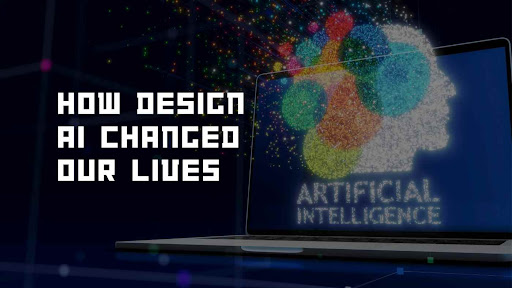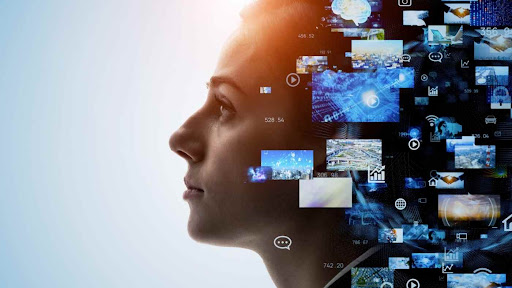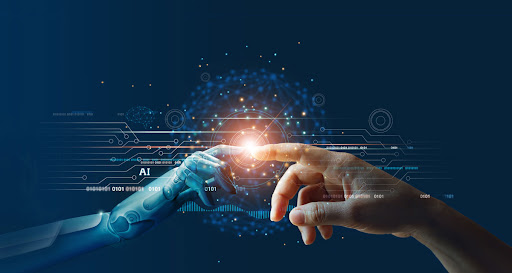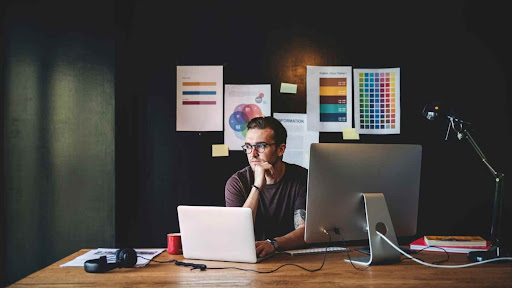Impact of Artificial Intelligence - How Design AI Changed Our Lives

Artificial Intelligence (AI) has become a buzzword and revolutionized the world, transforming the way we work, communicate, and interact with our surroundings. Understanding what artificial intelligence is has become essential as AI technologies have become increasingly sophisticated and widespread, finding their applications across various industries. In the design industry, AI has transformed the process by using design automation tools like a website builder, banner maker, text-to-image generator, mockup generator,graphic design creator, and logo maker, resulting in the easier and faster creation of high-quality designs. AI has streamlined manufacturing and production processes through creation automation, reducing costs and increasing efficiency. Healthcare has witnessed an improvement in patient outcomes and efficiency through personalized treatment plans and AI-powered surgical robots.
Personalized learning experiences and virtual tutors are changing the way we learn while self-driving cars and AI-powered traffic management systems have transformed the transportation industry.
However, AI has raised concerns about potential risks and ethical implications. Technology has the potential to replace human jobs, exacerbate inequalities, and even pose existential risks to humanity. It is vital to understand the benefits and challenges of AI and develop strategies for harnessing its power while mitigating its risks.
In conclusion, AI has had a profound impact on our lives and will continue to shape our future. From design automation to personalized healthcare and graphic design tools, AI is transforming almost every aspect of our lives. As we navigate the complex landscape of AI, it is essential to balance its potential benefits with its potential risks, ensuring that the technology is used ethically and responsibly for the betterment of society.

Artificial Intelligence (AI) has had a profound impact on our lives, transforming the way we work, communicate, and interact with the world around us. As AI technologies continue to evolve and become more sophisticated, they are finding their applications in many industries and aspects of our daily lives. Here are some short relevant statistics and fun facts that highlight the impact of AI and how it has changed our lives.
- According to a report by MarketsandMarkets, the global AI market in the design market is expected to reach $2.7 billion by 2023.
- A survey by PwC found that 72% of business executives believe that AI will be a "business advantage" shortly.
- AI-powered creation automation has led to a 30% reduction in defects and a 25% increase in throughput for manufacturing processes, according to a study by McKinsey.
- Adobe's AI-powered graphic design tool, Adobe Sensei, can automatically generate color palettes and suggest design layouts based on user input.
- The AI-powered logo generator, Logojoy, has created over 3 million logos for small businesses and entrepreneurs.
- Google's DeepMind AI has been used to predict acute kidney injury in hospitalized patients with an accuracy of 90%, according to a study published in Nature.
- AI-powered voice assistants like Amazon's Alexa and Apple's Siri have become increasingly popular, with over 157 million smart speakers sold worldwide in 2020.
- AI-powered recommendation systems have been shown to increase revenue for online retailers by up to 30%, according to a study by McKinsey.
What is Artificial Intelligence?
The field of computer science known as artificial intelligence (AI) involves the development of algorithms and computer systems able to carry out tasks that would normally need human intelligence, such as visual perception, speech recognition, decision-making, and language translation. AI technologies have become increasingly sophisticated and widespread, finding applications across various industries, including design.

AI has transformed the design industry through design automation tools like logo generators, graphic design creators, and t-shirt makers, streamlining the design process by automating repetitive and time-consuming design tasks such as resizing images, selecting colors, and arranging elements on a page, freeing up designers to focus on more creative tasks like ideation and conceptualization.
One example of AI in design is the use of logo generators. Logo generators are AI-powered tools that allow designers to quickly create logos by selecting from a library of pre-designed elements, fonts, and colors. Logo generators use machine learning algorithms to analyze existing logos and identify patterns and styles that are most likely to resonate with users. This allows designers to create logos that are more likely to be effective and appealing to their target audience.
Another example of AI in design is the use of graphic design creators. Graphic design creators are AI-powered tools that allow designers to quickly create graphics, posters, and other design elements by selecting from a library of pre-designed templates and elements. Graphic design creators use machine learning algorithms to analyze design trends and user preferences and generate designs that are most likely to be effective and appealing.
Similarly, AI website builders like Hocoos make it possible to create business-ready websites in seconds. All you have to do is answer a few questions about the type of website you want. The AI algorithm will analyze your needs and create the website accordingly with the right design elements, images, and AI-generated text.
Design automation is just one example of creation automation enabled by AI. Creation automation involves using AI algorithms to automate the creation of products and services. Automation has transformed manufacturing and production processes, resulting in greater efficiency and reduced costs. For example, AI-powered robots can perform repetitive and dangerous tasks in factories, reducing the risk of workplace accidents and injuries. AI algorithms can also optimize production schedules and minimize waste, resulting in cost savings and environmental benefits.
AI improves healthcare by creating personalized treatment plans and enhancing surgical precision through AI-powered robots. Patient data, including medical history, genetic information, and diagnostic results, is analyzed by AI algorithms to develop customized treatment plans. Surgical robots with AI technology can perform complex procedures with precision and accuracy, minimizing the risk of complications and improving patient outcomes.
AI's benefits are accompanied by concerns regarding potential risks and ethical implications, including job displacement, inequality, and existential risks. It is crucial to comprehend AI's benefits and challenges and devise strategies that leverage its potential while minimizing the associated risks.

The Future of Graphic Design
The graphic design industry is constantly evolving, and the rise of artificial intelligence (AI) is transforming the way designers work. With the advent of AI in design, design automation, and creation automation have become increasingly sophisticated, resulting in faster and more efficient design processes.
AI-powered graphic design tools such as logo generators, graphic design creators, and t-shirt makers have revolutionized the design industry. AI-powered logo generators analyze a company's industry, mission, and target audience to create logos that are visually appealing and effectively communicate the brand's message. Graphic design creators utilize machine learning algorithms to generate design elements and styles that align with a company's branding, color scheme, and typography. T-shirt makers leverage AI to streamline the process of creating custom designs for clothing, making it easier and faster to produce unique designs.
Design automation tools such as these allow designers to focus more on the creative aspects of their work and less on the technical details. They can use AI-powered tools to automate repetitive tasks, such as resizing and cropping images, allowing them to spend more time on the conceptualization and execution of design projects.
AI-powered creation automation is rapidly streamlining the design process, enabling entire design projects to be completed with minimal human intervention. By analyzing data on a brand's audience, preferences, and marketing goals, AI algorithms generate customized designs that are optimized for specific audiences and channels.
The future of graphic design is tied to AI, and designers who embrace this technology will have a competitive edge in the industry. AI-powered tools are already being used to create sophisticated and aesthetically pleasing designs, and as the technology continues to improve, the possibilities are endless.
However, the rise of AI in graphic design also raises concerns about the role of human designers in the industry. While AI-powered tools can automate many of the technical aspects of design, there is still a need for human creativity and intuition in the design process. Designers must learn to adapt to these new technologies and find ways to integrate them into their workflow while also retaining their unique human touch.
AI-powered design tools are revolutionizing the graphic design industry, offering faster and more efficient design processes and opening up new possibilities for customized and optimized designs. However, there are also ethical and inclusive concerns that need to be addressed, as biased or limited data can perpetuate stereotypes or exclude certain groups. Designers must balance automation with human creativity and work to mitigate potential challenges and limitations to stay at the forefront of the field.
The Benefits of AI in the Design Industry
Artificial Intelligence (AI) has transformed the design industry by introducing new technologies that streamline the design process and reduce the time and effort required to create high-quality designs. AI-powered design automation tools like a graphic design creator, and video intro maker are just a few examples of how AI has revolutionized the design industry.
One of the most significant benefits of AI in the design industry is the speed and efficiency with which designs can be created. Design automation tools powered by AI can generate logos, graphic designs, and other visual content in a matter of seconds, drastically reducing the time and cost required to create custom designs. This has made design services more accessible to small businesses and individuals who may not have the resources to hire professional designers.
AI-powered design tools also can learn and adapt over time, allowing them to create increasingly sophisticated designs that match the preferences and styles of individual users. This level of personalization and customization would be difficult to achieve manually, but with AI, it becomes much easier.
Another significant benefit of AI in the design industry is the ability to analyze large datasets and use them to inform design decisions. AI-powered tools can analyze trends, customer preferences, and other data points to help designers create designs that are more likely to resonate with their target audience. This can lead to more effective marketing campaigns and better customer engagement.
Design automation tools powered by AI also have the potential to reduce the risk of human error. Designers can use these tools to automate repetitive tasks and eliminate the potential for mistakes. This can be particularly useful in industries where design accuracy is critical, such as architecture or engineering.
AI-powered design tools also have the potential to democratize design by making it more accessible and affordable to a wider range of people. By automating the design process, AI can eliminate the need for specialized design skills and software, making it easier for anyone to create high-quality designs.
Finally, AI in the design industry has the potential to create entirely new design possibilities. As AI technology continues to evolve, designers will have access to new tools and techniques that were previously unimaginable. For example, AI-powered generative design tools can create designs that are not unique but also optimized for specific applications.
AI has brought several benefits to the design industry, including faster and more efficient design processes, personalized solutions, improved data analysis, reduced human error, increased accessibility to design tools, and expanded design possibilities. As AI technology continues to evolve, designers will have access to new tools and techniques that will continue to transform the design industry.
Conclusion
In conclusion, AI has brought numerous benefits to the design industry, streamlining the process of creating high-quality designs through design automation tools like logo generators, graphic design creators, and t-shirt makers. These tools have not only made the design process faster and more efficient but also more accessible and affordable for small businesses and individuals. AI has also enabled designers to focus on more creative and strategic aspects of their work, allowing them to produce better results.
However, as with any technology, there are concerns about the potential risks and ethical implications of AI in the design industry. The issue of intellectual property rights and the potential for AI to infringe upon them is of particular concern. Moreover, there is a risk that AI may replace human designers, leading to job displacement and inequality. Therefore, AI in the design industry is essential.
Overall, AI in the design industry is a promising development that has brought significant benefits and will continue to shape the future of design. By embracing AI and leveraging its capabilities, designers can create better designs faster and more efficiently while developing new design applications and exploring new design territories. It is crucial to balance the benefits of AI with its potential risks and ethical considerations, ensuring that the technology is used for the betterment of society as a whole.
Copyright © . All Rights Reserved